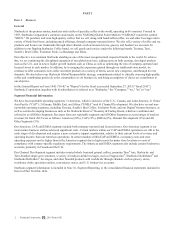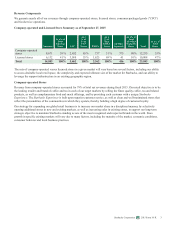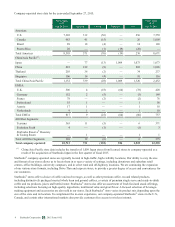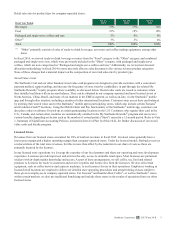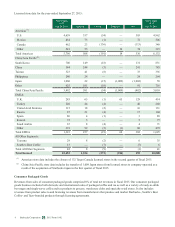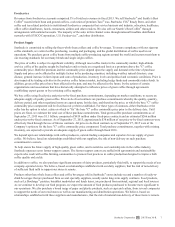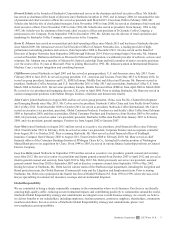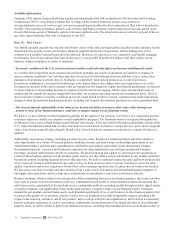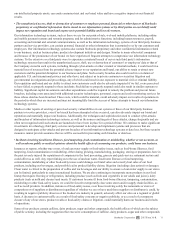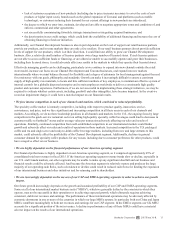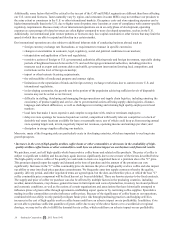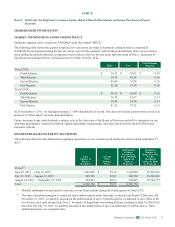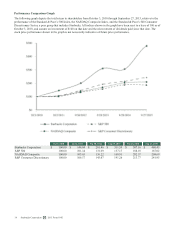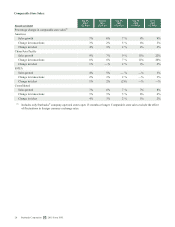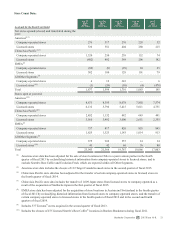Starbucks 2015 Annual Report Download - page 16
Download and view the complete annual report
Please find page 16 of the 2015 Starbucks annual report below. You can navigate through the pages in the report by either clicking on the pages listed below, or by using the keyword search tool below to find specific information within the annual report.
can lead to a variety of adverse health effects. Particularly in the U.S., there is increasing consumer awareness of health risks,
including obesity, due in part to increased publicity and attention from health organizations, as well as increased consumer
litigation based on alleged adverse health impacts of consumption of various food products. While we have a variety of
beverage and food items, including items that are coffee-free and have reduced calories, an unfavorable report on the health
effects of caffeine or other compounds present in our products, whether accurate or not, or negative publicity or litigation
arising from certain health risks could significantly reduce the demand for our beverages and food products and could
materially harm our business and results of operations.
• We rely heavily on information technology in our operations, and any material failure, inadequacy, interruption or
security failure of that technology could harm our ability to effectively operate our business and could adversely affect our
financial results.
We rely heavily on information technology systems across our operations, including for administrative functions, point-of-sale
processing and payment in our stores and online, management of our supply chain, Starbucks Cards, online business, mobile
technology, including mobile payments and ordering apps, reloads and loyalty functionality and various other processes and
transactions. Our ability to effectively manage our business and coordinate the production, distribution and sale of our products
depends significantly on the reliability, integrity and capacity of these systems. We also rely on third party providers and
platforms for some of these information technology systems and support, including a small number of large third party
providers for some of our administrative functions. Additionally, our systems are not fully redundant within a market or across
our markets. As a result, we may be unable to use information systems in one market to cover system failures in such market or
another market. Although we have security measures in place, they may not be effective in preventing the failure of these
systems or platforms to operate effectively and be available. Such failures may be caused by various factors, including power
outages, catastrophic events, problems with transitioning to upgraded or replacement systems or platforms, flaws in third party
software, errors by our employees or third party service providers, or a breach in the security of these systems or platforms,
including through cyber-attacks discussed in more detail in this risk factors section. If our disaster recovery and business
continuity plans do not resolve these issues in an effective manner they could cause material negative impacts to our product
availability and sales, the efficiency of our operations and our financial results.
• We may not be successful in implementing important strategic initiatives or effectively managing growth, which may have
an adverse impact on our business and financial results.
There is no assurance that we will be able to implement important strategic initiatives in accordance with our expectations,
which may result in an adverse impact on our business and financial results. These strategic initiatives are designed to create
growth, improve our results of operations and drive long-term shareholder value, and include:
• being an employer of choice and investing in employees to deliver a superior customer experience;
• building our leadership position around coffee;
• increasing the scale of the Starbucks store footprint with disciplined global expansion and introducing flexible and
unique store formats;
• creating new occasions in stores across all dayparts with new product offerings;
• continuing the global growth of our Channel Development business;
• delivering continued growth in our tea business through the Teavana brand; and
• driving convenience and brand engagement through our mobile, loyalty and digital capabilities.
In addition to other factors listed in this risk factors section, factors that may adversely affect the successful implementation of
these initiatives, which could adversely impact our business and financial results, include the following:
• increases in labor costs, both domestically and internationally, such as general market and minimum wage levels and
investing in competitive compensation, increased health care and workers’ compensation insurance costs and other
benefits to attract and retain high quality employees, whether due to regulatory mandates or changing industry
practices;
• increasing competition in channels in which we operate or seek to operate from new and existing large competitors
that sell high-quality specialty coffee beverages;
• construction cost increases associated with new store openings and remodeling of existing stores; delays in store
openings for reasons beyond our control or a lack of desirable real estate locations available for lease at reasonable
rates, either of which could keep us from meeting annual store opening targets in the U.S. and internationally;
• not successfully scaling our supply chain infrastructure as our product offerings increase and as we continue to
expand;
• the ability of our licensee partners to implement our growth platforms and product innovation;
12 Starbucks Corporation 2015 Form 10-K


